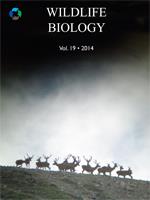To understand large scale animal—habitat associations, biologists often rely on intensive home-range based studies, where a large number of locations are obtained from relatively few individuals equipped with radio transmitters and then extrapolate patterns of habitat use to much larger areas. Alternatively, extensive methods (e.g. incidental observations) that provide few observations per individual can be effectively used to sample large areas. Both methods have advantages, limitations, and potential sources of bias. We used these different approaches in an effort to identify habitat features that may be important to expanding populations of bobcats Lynx rufus in New Hampshire, USA. Twelve adult bobcats with GPS-equipped transmitters provided detailed summaries of movement patterns within a 2300-km2 study area. We also solicited incidental observations from citizens throughout the state (24 200 km2). Using locations from both methods, we developed logistic models based on a comparison of home range composition to study area composition (second-order habitat selection). We also explored an approach to reduce potential bias associated with incidental observations (overrepresentation of human population centers) by applying a weighing factor. The telemetry and uncorrected observation-based models overlapped substantially with eight common covariates. The telemetry-based model indicated that bobcats preferred areas with few roads, limited human development, high stream densities, and steep topography. In contrast, the adjusted (to reduce bias) observation-based model indicated bobcats preferred areas with an abundance of roads and development with few streams and limited topographic variation. Because of these differences, we recommend caution when using sightings to model habitat associations unless biases associated with such information can be identified and overcome. Although public sightings had limited application for describing bobcat habitat, they were useful in documenting a recent range expansion and revealing novel prey use by bobcats.
How to translate text using browser tools
1 August 2014
Modeling bobcat Lynx rufus habitat associations using telemetry locations and citizen-scientist observations: are the results comparable?
Derek J. A. Broman,
John A. Litvaitis,
Mark Ellingwood,
Patrick Tate,
Gregory C. Reed





